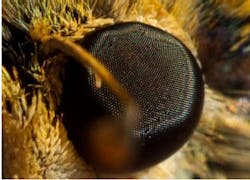Coating copies the eye of a moth
Anti-reflective coatings (ARCs) based on nanomaterials are used in most optical devices, including glasses, lenses, TV screens, solar cells, and LED lights.
Some of the most efficient ARCs are found in the eyes of insects. The eyes of moths, for example, are covered with nanoscopic structures which allow almost no light to reflect off the surface. The natural coating eliminates glare, hiding the moths from predators and improving their nocturnal vision.
Recently, a group at the Max Planck Institute for Intelligent Systems (Stuttgart, Germany) co-ordinated by Professor Joachim Spatz has developed a new way to artificially produce moth eye-like coatings. According to the researchers, the coatings have a cost similar to that of existing ARCs.
The manufacturing process developed at the Max Planck Institute produces regular, tiny bumps on the surface of a material that are similar to those found in the moths' eyes. The group claims that the parameters of the structures -- such as period, height and shape -- can be easily controlled.
According to a news item on The European Media Research Center website, the researchers have now formed a spin-off team to exploit and commercialize their idea.
This, however, isn't the first time that such work has been undertaken. In 2007, Vision Systems Design reported on efforts by researchers at the Manufacturing Engineering Centre (MEC) at Cardiff University (Cardiff, UK) to create an industrial lens for use in a low light environment that was also inspired by the eye of the moth.
Recent articles on biomimetics that you might also be interested in.
1. High-speed camera system studies dragonflies for biomechanical research
Researchers at Harvard University (Cambridge, MA, USA) are studying the motion of dragonflies to gain an appreciation for the mechanisms associated with insect locomotion.
2. High-speed cameras capture a vision of painted ladies in flight
Engineers at Johns Hopkins University (Baltimore, Maryland, USA) have been using high-speed video cameras to capture images of butterflies in flight in the hope of understanding how they might be able to mimic their maneuvers in the design of micro aerial vehicles (MAVs).
3. High-speed imaging helps check fly flight
European researchers have deployed a high-speed vision system for real-time analysis of the wing kinematics of tethered flying fruit flies.
Vision Systems Design magazine and e-newsletter subscriptions are free to qualified professionals. To subscribe, please complete the form here.
-- Dave Wilson, Senior Editor, Vision Systems Design
